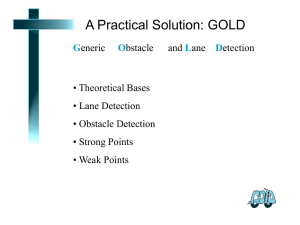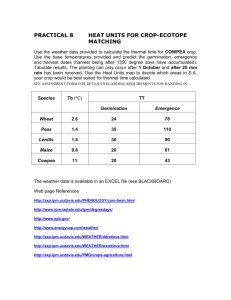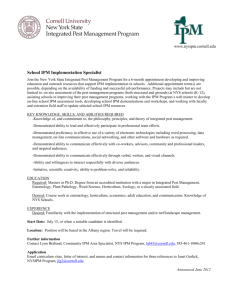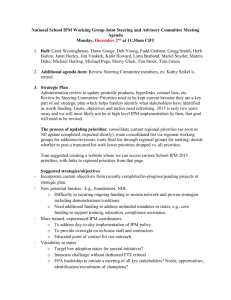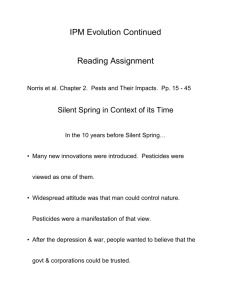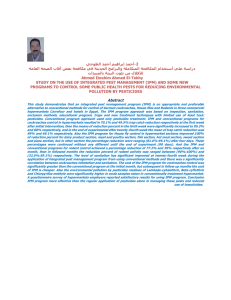Numerical_Comp
advertisement
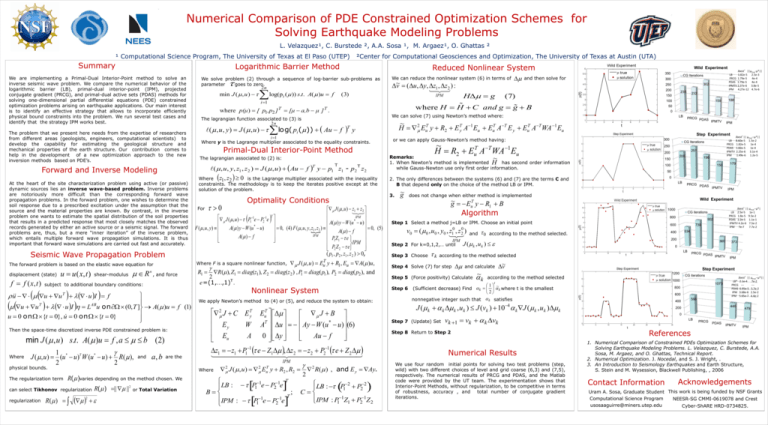
Numerical Comparison of PDE Constrained Optimization Schemes for
Solving Earthquake Modeling Problems
L. Velazquez¹, C. Burstede ², A.A. Sosa ¹, M. Argaez¹, O. Ghattas ²
¹ Computational Science Program, The University of Texas at El Paso (UTEP)
Summary
Logarithmic Barrier Method
We are implementing a Primal-Dual Interior-Point method to solve an
inverse seismic wave problem. We compare the numerical behavior of the
logarithmic barrier (LB), primal-dual interior-point (IPM), projected
conjugate gradient (PRCG), and primal-dual active sets (PDAS) methods for
solving one-dimensional partial differential equations (PDE) constrained
optimization problems arising on earthquake applications. Our main interest
is to identify an effective strategy that allows to incorporate efficiently
physical bound constraints into the problem. We run several test cases and
identify that the strategy IPM works best.
The problem that we present here needs from the expertise of researchers
from different areas (geologists, engineers, computational scientists) to
develop the capability for estimating the geological structure and
mechanical properties of the earth structure. Our contribution comes to
help in the development of a new optimization approach to the new
inversion methods based on PDE’s.
Forward and Inverse Modeling
At the heart of the site characterization problem using active (or passive)
dynamic sources lies an inverse wave-based problem. Inverse problems
are notoriously more difficult than the corresponding forward wave
propagation problems. In the forward problem, one wishes to determine the
soil response due to a prescribed excitation under the assumption that the
source and the material properties are known. By contrast, in the inverse
problem one wants to estimate the spatial distribution of the soil properties
that results in a predicted response that most closely matches the observed
records generated by either an active source or a seismic signal. The forward
problems are, thus, but a mere “inner iteration” of the inverse problem,
which entails multiple forward wave propagation simulations. It is thus
important that forward wave simulations are carried out fast and accurately.
f f ( x, t )
u u ( x, t ),
u u
R
, and force
u I f
u I L u on (0,T ] A( )u f
AB
Then the space-time discretized inverse PDE constrained problem is:
min J ( , u ) s.t. A( )u f , a b (2)
1 *
T
*
J ( , u ) (u u ) W (u u ) R( ),
2
2
and
a, b
are the
physical bounds.
The regularization term
min J ( , u )
R( )varies depending on the method chosen. We
R( ) || ||2
R( )
2
log(pi ( )) s.t. A( )u f
( 3)
or Total Variation
~
v (u , y, z1 , z 2 ) :
log( p ( )) Au f
T
i
y
i 1
Where y is the Lagrange multiplier associated to the equality constraints.
Primal-Dual Interior-Point Method
T
T
y p1 z1 - p2 z 2
Where z1, z2 0 is the Lagrange multiplier associated with the inequality
constraints. The methodology is to keep the iterates positive except at the
solution of the problem.
Optimality Conditions
0
We apply Newton’s method to (4) or (5), and reduce the system to obtain:
2 J C E Ty
W
Ey
Eu
A
J B
*
A u Ay W (u u )(6)
0 y
Au f
T
Eu
T
J ( , u)
2
T
Eu
2
y R2 , R2
1
1 T
LB : P1 e P2 e
B
;
T
1
1
IPM : P e P e
1
2
2
(7)
0
R( ) , and E y Ay.
LB : P2 P2
1
2
C
1
1
IPM : P1 Z1 P2 Z 2
PRCG PDAS
IPMTV
IPM
Step 2 For k=0,1,2,… until
k
205
150
150
~
k
0
LB
PRCG PDAS
IPMTV
IPM
Wild Experiment
1000
Jbest* || µtrue--µ*|
LB 2.5e-5 1e-1
PRCG 1.8e-5 9.5e-2
PDAS 2.2e-5 1.1e-1
IPMTV 4.2e-6 7.5e-2
IPM 7e-7
7.7e-2
CG iterations
800
902
600
739
534
400
200
360
373
0
LB
PRCG PDAS
IPMTV
v~
1200
according to the method selected
nonnegative integer such that k satisfies
4
J ( k k k , uk ) J (vk ) 10 k J (
1073
800
600
Jbest* || µtrue--µ*||
LB* 2.1e-4 7e-2
PRCG ----PDAS 6.95e-5 5.7e-2
IPM 3.68e-6 2.5e-2
IPM 5.65e-7 4.4e-2
566
400
k , uk ) k
446
200
479
0
vk 1 vk k vk
We use four random initial points for solving two test problems (step,
wild) with two different choices of level and grid coarse (6,3) and (7,5),
respectively. The numerical results of PRCG and PDAS, and the Matlab
code were provided by the UT team. The experimentation shows that
Interior-Point Methods, without regularization, to be competitive in terms
of robustness, accuracy , and total number of conjugate gradient
iterations.
CG iterations
1000
t
IPM
Step Experiment
1 ~
(Sufficient decrease) Find k k where t is the smallest
2
179
50
according to the method selected.
and calculate
196
100
J ( k , uk )
Step 5 (Force positivity) Calculate
251
according to the method selected
Step 4 Solve (7) for step
Step 6
CG Iterations
200
Step 1 Select a method j=LB or IPM. Choose an initial point
0
Jbest* || µtrue--µ*||
LB 8.60e-5 1.5e-2
PRCG 1.82e-5
1e-4
PDAS 1.82e-5
1e-4
IPMTV 2.25e-6 3.1e-4
IPM
1.49e-6 1.2e-5
250
Algorithm
and
IPM
Step Experiment
does not change when either method is implemented
T
~
g Eu y R1 B
v0 ( 0 , u0 , y0 , z10 , z 20 )
188
50
300
Numerical Results
2
~
g
Jbest* ||µtrue-µ*||
LB
1.82e-5 2.5e-3
PRCG 1.79e-5
4e-4
PDAS 1.79e-5
4e-4
IPMTV 2.37e-6 3.8e-5
IPM 4.27e-12 4.7e-6
232
159
LB
Step 8 Return to Step 2
235
100
2. The only differences between the systems (6) and (7) are the terms C and
B that depend only on the choice of the method LB or IPM.
Step 7 (Update) Set
1
1
z1 z1 P1 e Z1 , z 2 z 2 P2 e Z 2
IPM
H g
~
T T
1
H R2 Eu A WA Eu
Step 3 Choose
T
Eu y R1, Eu
302
150
or we can apply Gauss-Newton’s method having:
3.
z1 z 2
J ( , u )
T
IPM
1
1
J ( , u ) P e P e
A( ) y W (u * u )
1
2
0, (5)
*
F ( , u, y )
A( ) y W (u u )
0
,
(
4
)
F
(
,
u
,
y
,
z
,
z
)
1 2
A
(
)
f
IPM
P Z e
A
(
)
f
1 1
IPM
P2 Z 2 e
For
300
200
Remarks:
~
1. When Newton’s method is implemented H has second order information
while Gauss-Newton use only first order information.
The lagrangian associated to (2) is:
CG Iterations
~
2 T
T 1
T T
T T
1
H Eu y R2 E y A Eu Eu A E y Eu A WA Eu
2n
( , u , y, z1 , z 2 ) J ( , u ) Au f
and then solve for
We can solve (7) using Newton’s method where:
The lagrangian function associated to (3) is
T
350
˜ C and g g
˜B
where H H
where p(μ ) [ p1,p2 ] T [μ a,b μ ] T .
( , u , y ) J ( , u )
Wild Experiment
250
IPM
Nonlinear System
(1)
We can reduce the nonlinear system (6) in terms of
i 1
Where
can select Tikhonov regularization
regularization
2n
T
u 0 on {t 0}, u 0 on {t 0}
Where
J ( , u)
A( )u,
R1 R( ), Z1 diag(z1), Z 2 diag(z 2 ) , P1 diag(p1), P2 diag(p2 ), and
2
e = (1,,1)T .
subject to additional boundary conditions:
u u u
T
shear-modulus
We solve problem (2) through a sequence of log-barrier sub-problems as
parameter
goes to zero.
Where F is a square nonlinear function,
The forward problem is based on the elastic wave equation for
n
Reduced Nonlinear System
( p1 , p2 , z1 , z 2 ) 0,
Seismic Wave Propagation Problem
displacement (state)
²Center for Computational Geosciences and Optimization, The University of Texas at Austin (UTA)
LB
References
PRCG
PDAS
IPMTV
IPM
1. Numerical Comparison of Constrained PDEs Optimization Schemes for
Solving Earthquake Modeling Problems. L. Velazquez, C. Burstede, A.A.
Sosa, M. Argaez, and O. Ghattas, Technical Report.
2. Numerical Optimization. J. Nocedal, and S. J. Wright, .
3. An Introduction to Seismology Earthquakes and Earth Structure,
S. Stein and M. Wysession, Blackwell Publishing, , 2006
Contact Information
Acknowledgements
Uram A. Sosa, Graduate Student This work is being funded by NSF Grants
Computational Science Program
NEESR-SG CMMI-0619078 and Crest
usosaaguirre@miners.utep.edu
Cyber-ShARE HRD-0734825.



